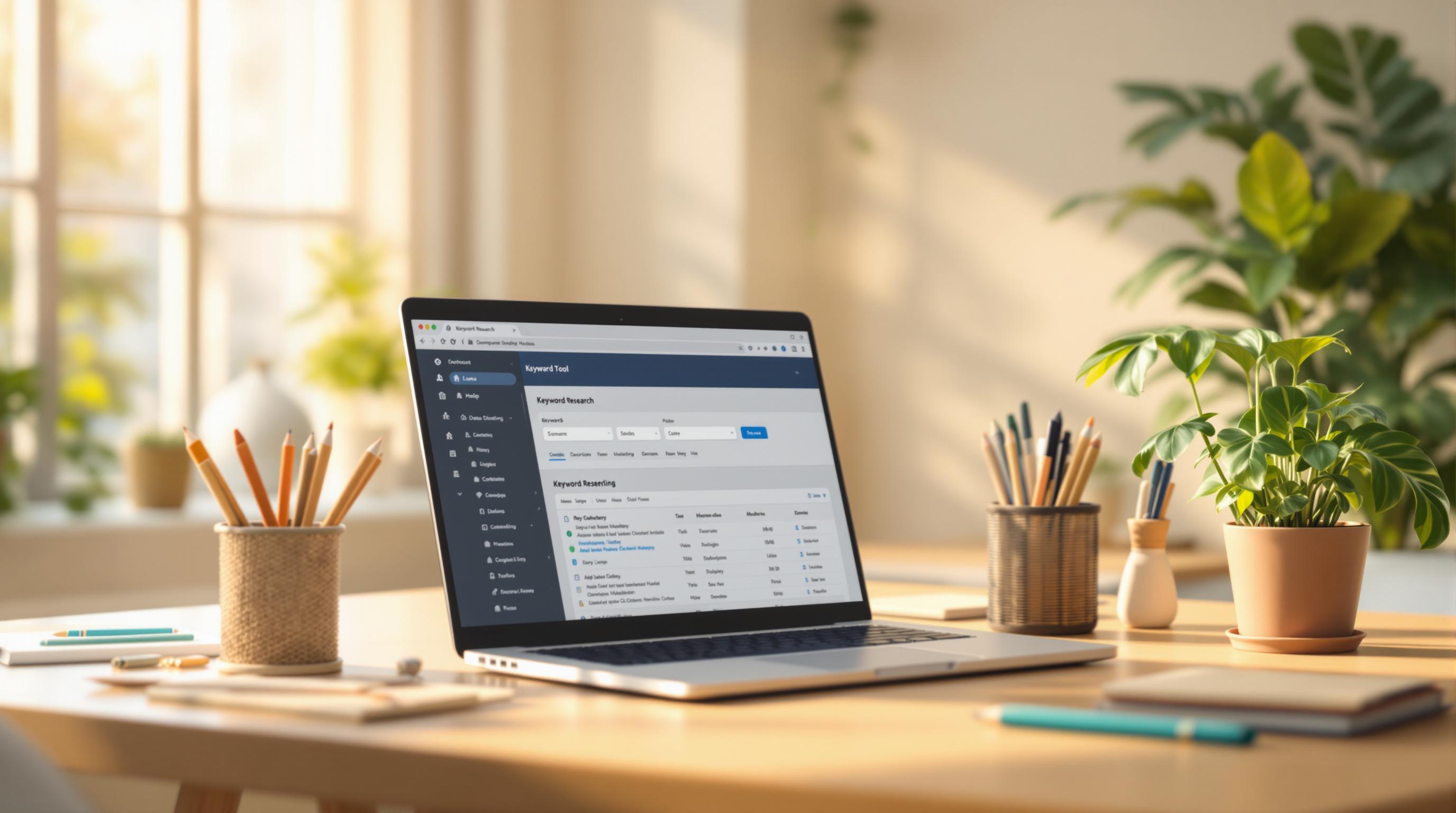Voice search is changing how people find information online. By 2025, over 50% of all searches are expected to be voice-based, with 71% of consumers already preferring voice queries. This shift makes it essential for businesses to optimize for voice search while meeting accessibility standards like WCAG 2.2 and ADA compliance.
Here’s what you need to know:
- Why It Matters: Voice search is faster, conversational, and heavily used for local queries. Accessibility ensures inclusivity, especially for the 15% of the global population with disabilities.
- Key Strategies:
- Use natural language keywords and question-based phrases.
- Implement speakable schema markup for text-to-speech optimization.
- Ensure mobile-friendly design with proper font sizes, touch targets, and fast loading speeds.
- Follow accessibility guidelines like semantic HTML, ARIA landmarks, and descriptive alt text.
- Local Optimization: Update your Google Business Profile with voice-friendly descriptions and accessibility details. Use location-specific keywords and schema to enhance visibility.
- The Impact: Businesses that combine voice search optimization with accessibility improvements see better user engagement, higher rankings, and reduced legal risks.
Voice Search Optimization | Difference Between Traditional and Voice Search | Intellipaat
Content Standards for Voice Search and Accessibility
As voice search continues to grow and accessibility becomes a non-negotiable aspect of content creation, it's crucial to develop strategies that cater to both. Here's how you can optimize your content to meet these demands.
Natural Language Keywords
Voice search behaves differently from traditional typed queries. People tend to use longer, more conversational phrases when speaking. To align your content with this trend:
- Focus on question-based phrases like "who", "what", "where", "when", "why", and "how."
- Write in full, conversational sentences that mirror how people naturally speak.
- Incorporate location-specific terms, as voice searches are three times more likely to include local intent.
These adjustments not only improve your content's visibility in voice search but also make it more user-friendly.
"It's a more nuanced approach to SEO, but the data is clearly demonstrating its effectiveness as we move towards the age of voice search. And we always want to move towards better meeting user needs through our marketing efforts." - Brooker Webber, Head of Marketing at Ninja Patches
Accessible Content Structure
A well-structured page benefits both voice search and accessibility tools. By focusing on semantic and navigational elements, you ensure your content is easy to interpret for both users and technology.
| Element | Purpose | Impact on Voice Search |
|---|---|---|
| Semantic HTML | Defines content meaning | Improves content interpretation |
| ARIA Landmarks | Identifies page regions | Facilitates content discovery |
Content that directly answers specific questions is 3-5 times more likely to appear in voice search results. Additionally, mobile-friendly pages are 1-3 times more likely to rank higher.
Speakable Content Markup
Speakable schema markup is a powerful tool for optimizing content for text-to-speech (TTS) playback. It not only enhances voice search performance but also aligns with mobile-first design principles.
To implement it effectively:
- Keep sections short and concise, ideally 20–30 seconds long.
- Highlight only the most essential points.
- Ensure the content is accurate and clear.
For instance, The New York Times saw a 20% boost in organic voice search traffic and improved engagement rates after integrating speakable structured data.
"Voice search and accessibility rely on the same thing: clear structure, thoughtful design, and content that makes sense to both people and machines." - Greg McNeil, 216digital
Technical Requirements
To optimize for voice search and improve accessibility, focus on performance and structure. Back in 2018, 27% of global users relied on mobile voice search. These technical adjustments not only enhance user engagement but also meet strict accessibility standards.
Mobile Design Standards
Meeting mobile design requirements is crucial for usability. Here's a breakdown of key elements:
| Design Element | Requirement | Impact |
|---|---|---|
| Viewport Settings | Use a meta viewport tag with proper scaling | Ensures content displays correctly on all devices |
| Touch Targets | Minimum size of 44x44 pixels | Makes interactions easier for users with motor impairments |
| Font Size | Minimum base size of 16px | Improves readability without needing to zoom |
| Color Contrast | WCAG 2.1 AA compliance (4.5:1 ratio) | Enhances visual accessibility for all users |
"Naturally how your content appears on mobile device is arguably the most important consideration when it comes to accessibility." - Carlos A. Espitia, Managing Director, CAE Marketing & Consulting, Inc.
Beyond mobile design, structuring your data with schema is essential for voice search optimization.
Voice Search Schema
Structured data plays a major role in improving voice search results. For instance, in April 2025, Digitech Web Design reported a 20% increase in organic traffic after implementing FAQ schema. Incorporate the following schema types:
- Speakable Schema: Tailors content for text-to-speech functionality.
- FAQ Schema: Organizes question-and-answer content for voice assistants.
- LocalBusiness Schema: Boosts visibility for local voice-based searches.
- HowTo Schema: Formats step-by-step guides for voice readouts.
Fast page loading times also directly impact voice search performance.
Page Speed for Voice Search
Voice search results are known to load in under five seconds, making speed optimization a priority. Here are some key areas to focus on:
| Optimization Factor | Recommendation | Implementation Method |
|---|---|---|
| Image Optimization | Compress images effectively | Use modern formats like WebP and enable lazy loading |
| Server Performance | Ensure fast server response | Optimize hosting and implement browser caching |
| Code Optimization | Minify CSS and JavaScript | Use automated build tools |
| Resource Delivery | Improve asset delivery efficiency | Leverage a Content Delivery Network (CDN) |
"Technical SEO issues such as website speed, crawlability, or indexing problems can delay progress. We conduct comprehensive audits and prioritize technical optimizations early in the campaign." - Omar Muñoz, Co-Founder, REInvestor SEO
Speed matters: pages that load in just one second convert three times better than those taking five seconds. To maintain both speed and accessibility, focus on server-side rendering and browser caching.
Local Voice Search and Accessibility
Optimizing for local voice search means ensuring your business is not only easy to find but also accessible to everyone. With 58% of consumers relying on voice search to locate local business information, it’s clear that businesses need to adapt their digital strategies to stay relevant. This involves blending technical precision with content designed to improve accessibility.
Google Business Profile Setup
A strong Google Business Profile (GBP) plays a key role in local voice search success. To make your profile voice-search-friendly and accessible, focus on these essential elements:
| Profile Element | Optimization Tips | Accessibility Advantage |
|---|---|---|
| Business Description | Use natural, location-specific keywords | Makes it easier for screen readers to interpret |
| Photos | Include high-quality images with descriptive alt text | Provides important visual context |
| Q&A Section | Answer common questions in a conversational tone | Ensures clear and concise information access |
| Hours & Contact | Keep details accurate and consistently formatted | Enables reliable responses from voice assistants |
For instance, Golden Crust Pizza in San Francisco saw a 40% boost in voice-initiated orders within six months by updating their GBP with voice-friendly descriptions and regular updates.
Local Business Accessibility Markup
Using proper schema markup is crucial for ensuring voice assistants can accurately convey your business information. Here’s what to focus on:
- Local Business Schema: Add detailed schema to inform voice assistants about your business’s accessibility features.
- Speakable Schema: Highlight key content for voice search using Google’s speakable schema.
- Mobile Accessibility: Ensure your mobile site meets these standards:
| Feature | Requirement | Voice Search Advantage |
|---|---|---|
| Button Size | Minimum of 44x44 pixels | Improves tap target usability |
| Screen Reader Support | Use ARIA labels and roles | Enhances navigation for voice users |
| Content Structure | Maintain a clear heading hierarchy | Helps voice assistants parse information |
| Load Speed | Ensure pages load in under 5 seconds | Delivers faster voice search results |
Given that 1 in 4 U.S. adults live with some form of disability, prioritizing accessibility isn’t just a technical task - it’s a smart business move. By aligning voice search strategies with accessibility standards, businesses can create a more inclusive and effective local search experience for all users.
sbb-itb-5be333f
Quality Assurance Methods
Quality assurance plays a key role in ensuring both voice search functionality and accessibility compliance. With over 1 billion voice searches happening every month, businesses must prioritize rigorous testing to stay competitive in this growing market. A solid testing framework supports the technical optimizations discussed earlier, ensuring a seamless experience for all users.
Accessibility Tools Testing
Screen reader testing is a cornerstone of accessibility validation. Among these tools, NVDA leads the pack, used by 65.6% of screen reader users.
| Screen Reader | Platform | Key Testing Focus | Implementation Tips |
|---|---|---|---|
| NVDA | Windows | Navigation flow, content readability | Check tab order and proper heading structure |
| JAWS | Windows | Complex interactions, dynamic content | Confirm ARIA labels and form controls are accurate |
| VoiceOver | iOS/macOS | Mobile accessibility, touch targets | Test gesture navigation for consistency |
| TalkBack | Android | Mobile content, tap targets | Verify button sizes and spacing for usability |
Key areas for testing include:
- Content Structure: Ensure headings are correctly nested and that content flows logically.
- Interactive Elements: Confirm that buttons, forms, and other interactive features are labeled properly.
- Dynamic Content: Test for accessibility in dynamic updates, tab navigation, and keyboard functionality.
While accessibility is critical, tracking voice search performance is equally important for refining optimization strategies.
Voice Search Analytics
Google Search Console is an invaluable tool for evaluating voice search performance. Notably, around 40% of voice search results come from featured snippets, making them a critical metric to monitor.
| Metric | What to Monitor | Key Metrics |
|---|---|---|
| Question Queries | Long-tail keywords starting with who, what, where, when, why, how | Frequency of featured snippet appearances |
| Mobile Performance | Page speed and mobile usability | Maintain load times under 5 seconds |
| Local Search Visibility | Mentions of business name and location-based queries | Ranking in local pack results |
| Schema Implementation | Accuracy of structured data markup | Ensure error-free rich result data |
To maximize voice search efficiency, consider these strategies:
-
Regular Automated Testing
Use tools like Google Lighthouse and WAVE to identify and address common accessibility issues automatically. -
Manual Expert Testing
Schedule detailed reviews with accessibility specialists to catch issues that automated tools might miss. -
User Feedback Integration
Set up feedback channels for users with disabilities and frequent voice search users. Their insights can reveal practical challenges and usage patterns that technical tests may overlook.
Summary
By 2026, voice searches are projected to make up over 50% of all internet queries. This shift highlights the urgency for businesses to adapt their digital strategies to prioritize both accessibility and voice search optimization.
Voice search and accessibility go hand in hand. Currently, 28% of consumers rely on voice assistants daily, and the global voice search market is expected to hit $13.88 billion by 2030.
Here are some key areas to focus on for success in voice search accessibility:
| Focus Area | Implementation Strategy | Impact Metrics |
|---|---|---|
| Content Structure | Use clear headings, semantic HTML, and ARIA labels | Enhances compatibility with screen readers and improves voice search accuracy |
| Technical Elements | Apply schema markup, optimize for mobile, and improve page speed | Around 40–60% of voice search answers come from featured snippets |
| Local Presence | Optimize Google Business Profile and use local schema | 58% of US consumers use voice search to find local business information |
These strategies emphasize the strong connection between accessibility and effective voice search optimization, as detailed above.
"Voice search has introduced a new period of accessibility and inclusivity, giving power to people with disabilities and those who find traditional text-based interfaces challenging." - Microsoft
To thrive in this evolving landscape, businesses must focus on both technical precision and user experience. Implementing semantic markup, adopting mobile-first design, and creating conversational content are essential steps. These efforts not only ensure inclusivity but also strengthen search visibility.
With millions of users engaging in voice search every month, maintaining high accessibility standards is no longer optional - it’s a critical component of digital success.
FAQs
How can businesses optimize for voice search while ensuring accessibility compliance?
To ensure your website is ready for voice search and meets accessibility standards, following the Web Content Accessibility Guidelines (WCAG) is essential. Start by using clear, conversational language that mirrors how people naturally speak when using voice search. Structuring your content with proper semantics not only improves compatibility with screen readers but also provides a better experience for all users. Don’t forget to include alternative text for images and transcripts for audio content - these small steps make a big difference in accessibility.
Another key tip is to focus on conversational keywords. These are the phrases people are likely to say out loud when using voice search. Regularly testing your site with accessibility tools can help you spot and fix any barriers, making your website more inclusive and easier for everyone to navigate.
How does using speakable schema markup benefit voice search and accessibility?
Using speakable schema markup can greatly enhance your content's reach and usability. By enabling voice assistants to read your content aloud, it ensures that your information is accessible to people with disabilities or those who simply prefer listening over reading.
This feature also boosts your site's presence in voice search results by offering structured responses that voice assistants can easily process. With the growing reliance on smart devices for hands-free, quick answers, tailoring your content for audio playback not only improves accessibility but also keeps users more engaged.
Why should businesses optimize their Google Business Profile for voice search and accessibility?
Optimizing Your Google Business Profile for Voice Search
Getting your Google Business Profile ready for voice search is a smart move to boost local visibility and make your business more accessible to everyone. Voice search tends to focus on local results, so fine-tuning your profile increases the odds of showing up when people are looking for nearby services or businesses.
On top of that, aligning your profile and website with accessibility standards is a win-win. It helps users with disabilities navigate your content more easily and improves the overall experience for everyone. For example, structuring your site with semantic HTML not only makes it more voice-search friendly but also works seamlessly with assistive tools like screen readers. This approach creates a more inclusive online environment while giving your SEO a boost - search engines love websites that are easy to use and accessible to all.


